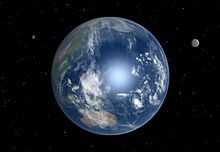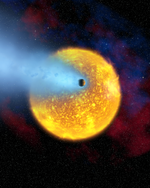Hypothetical astronomical object
Appearance
(Redirected from Hypothetical astronomical objects)




Various unknown astronomical objects have been hypothesized throughout recorded history. For example, in the 5th century BCE, the philosopher Philolaus defined a hypothetical astronomical object which he called the "Central Fire", around which he proposed other celestial bodies (including the Sun) moved.[1]
Types of hypothetical astronomical objects
[edit]Hypothetical astronomical objects have been speculated to exist both inside and outside of the Solar System, and speculation has included different kinds of stars, planets, and other astronomical objects.
- For hypothetical astronomical objects in the Solar System, see: List of hypothetical Solar System objects
- For hypothetical stars, see: Hypothetical star
- For hypothetical brown dwarfs, see: List of brown dwarfs
- For hypothetical black holes, see: Hypothetical black hole
- For extrasolar moons, all of which are currently hypothetical, see: Extrasolar moon
- For stars, planets or moons whose existence is not accepted by science, see: Planetary objects proposed in religion, astrology, ufology and pseudoscience and Stars proposed in religion
- For hypothetical planets in fiction, see: Fictional planets of the Solar System
Hypothetical planet types
[edit]Hypothetical types of extrasolar planets include:
| Type | Description |
|---|---|
| Ammonia planet [citation needed] | A planet with significant amounts of ammonia. May have lakes or oceans of ammonia. |
| Blanet | A planet that directly orbits a black hole. |
| Carbon planet | A terrestrial planet composed primarily of carbon, rather than silicon. |
| Chthonian planet | A hot Jupiter whose outer layers have been completely stripped off by its parent star. |
| Chlorine planet | A planet with significant amounts of free chlorine or hydrochloric acid and muriatic acid.[2] |
| Coreless planet | A terrestrial planet that has no metallic core. |
| Desert planet | A terrestrial planet with little to no water. |
| Extragalactic planet | A planet that is located outside the Milky Way galaxy |
| Eyeball planet | A tidally locked planet where uneven heating of the surface induces spatial features resembling a human eye. |
| Helium planet | A gas giant composed mainly of helium instead of hydrogen. |
| Hycean planet /ˈhaɪʃən/ | A hot, water-covered planet with a hydrogen-rich atmosphere that is possibly capable of harboring extremophilic life.[3][4][5] |
| Ocean planet | A planet whose surface is covered entirely by deep oceans. |
| Superhabitable planet | A terrestrial planet that is more habitable than Earth. |
| Tidally detached exomoon | A planet that was originally a moon but has become gravitationally detached. |
| Toroidal planet | A planet whose shape resembles a torus or doughnut. |
| Trojan planet | A planet that orbits near the L4 or L5 Lagrange points of a more massive object. |
References
[edit]- ^ Marco Ceccarelli, Distinguished Figures in Mechanism and Machine Science (2007), p. 124.
- ^ Haas, Johnson R. (November 2010). "The potential feasibility of chlorinic photosynthesis on exoplanets". Astrobiology. 10 (9): 953–963. Bibcode:2010AsBio..10..953H. doi:10.1089/ast.2009.0364. ISSN 1557-8070. PMID 21118026.
- ^ Madhusudhan, Nikku; Piette, Anjali a. A.; Constantinou, Savvas (26 August 2021). "Habitability and Biosignatures of Hycean Worlds". The Astrophysical Journal. 918 (1): 1. arXiv:2108.10888. Bibcode:2021ApJ...918....1M. doi:10.3847/1538-4357/abfd9c. S2CID 237290118.
- ^ Anderson, Paul Scott (29 August 2021). "Hycean planets might be habitable ocean worlds". Earth & Sky. Retrieved 12 December 2021.
- ^ Davis, Nicola (25 August 2021). "'Mini-Neptunes' beyond solar system may soon yield signs of life – Cambridge astronomers identify new hycean class of habitable exoplanets, which could accelerate search for life". The Guardian. Retrieved 12 December 2021.
